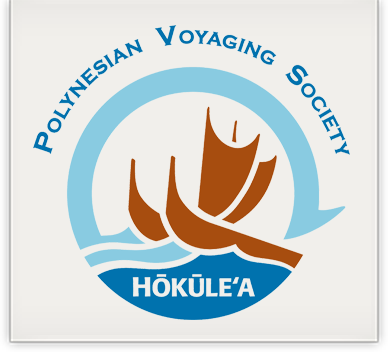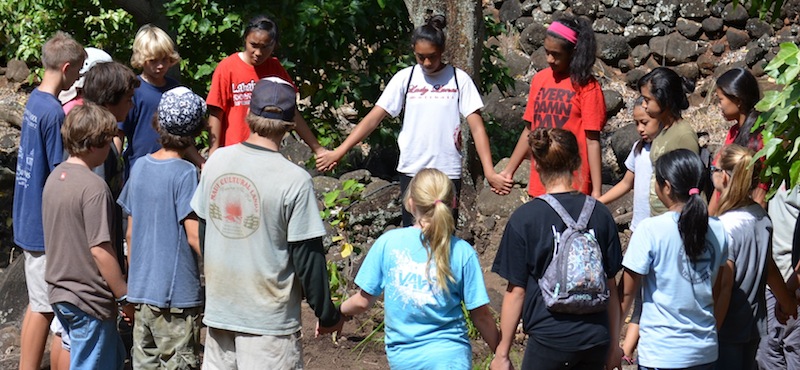Energy Around a Sense of Place
Energy Around a Sense of Place
Grades 6-8
Developed by MaryAnna Enriques, Sacred Hearts School
Please click here to contact the teacher
Thank you for checking out our curriculum. We would love to hear your feedback. Please click here to post your comments on our Mālama Honua Google+ community.
“Almost everything you do will seem insignificant but it is important that you do it.” – Gandhi
So often we feel that our actions or the energy of our actions have no significant impact on our environment. This unit, which can be customized to several weeks to a year, offers numerous opportunities for students to observe, hypothesize and share energy around a place. Students will begin the unit by learning about energy concepts in the concrete physical place and then move to semi-abstract concepts of people and their classroom environment. Students will deepen their understanding of energy by examining energy around the community with human-to-human interaction. The unit culminates into a metaphysical concept of energy interaction through the development of their own Learning Journeys.
There are many different kinds of energy in the world and those energies can transfer from one form to another causing consequences that can be harmful or beneficial to our place.
How do my mindful actions impact the various energy forms in my place?
Language Arts Writing:
W6.2, 7.2, 8.2 Write informative/explanatory texts to examine a topic and convey ideas, concepts, and information through the selection, organization, and analysis of relevant content.
W.6.6, 7.6, 8.6 Use technology including the Internet, to produce and publish writing and present the relationships between information and ideas efficiently as well as to interact and collaborate with others.
W.6.9, 7.9, 8.9 Draw evidence from literary or informational texts to support analysis, reflection, and research.
Speaking and Listening:
SL.8.1 Engage effectively in a range of collaborative discussions (one-on-one, in groups, and teacher-led) with diverse partners on grade 8 topics, texts, and issues, building on others’ ideas and expressing their own clearly.
SL6.4, 7.4, 8.4 Present claims and findings, emphasizing salient points in a focused, coherent manner with relevant evidence, sound valid reasoning, and well-chosen details; use appropriate eye contact, adequate volume, and clear pronunciation.
SL 6.5,7.5, 8.5 Integrate multimedia and visual displays into presentations to clarify information, strengthen claims and evidence, and add interest.
Science (Next Generation Science Standards) Energy:
MS-PS 3-1 Construct and interpret graphical displays of data to describe the relationships of kinetic energy to the mass of an object and to the speed of an object.
MS-PS3-5. Construct, use, and present arguments to support the claim that when the motion energy of an object changes, energy is transferred to or from the object. Math (Next Generation Science Standards)
MS PS 4. Use mathematical representations to describe a simple model for waves that includes how the amplitude of a wave is related to the energy in a wave.
Nā Honua Mauli Ola (NHMO Cultural Pathways)
ʻIke Pilina – Relationship Pathway
ʻIke Mauli Lāhui – Cultural Identity Pathway
ʻIke Naʻauao – Intellectual Pathway
ʻIke Hoʻokō – Applied Acheivement Pathway
ʻIke Honua – Sense of Place Pathway Values: kuleana (responsibility) and laulima (working together)
Present results of research using logic in speaking and writing to:
- Cite evidence for the links between human actions (energy) and effect or impact upon others and their surroundings
- Conduct interviews and interpret data to describe how human actions (energy) have affected others and their surroundings
- Laulima (work cooperatively) and demonstrate individual kuleana (responsibility) as a team member to present research into how individual choices and the energy put into those transfers to others’ actions (Ripple Effect)
- Use technology to enhance and support presentation of learning and ideas
- Present results of research using logic in speaking and writing
- Key concepts: Mindful, Sense of Place, energy, place-based education, spirituality, interdependence, interaction, sacredness, waves, passion, transference
Building/Activating the Background
1. Students will begin with a concrete and physical activity that relates to energy and place (i.e. yoga, karate, tai chi, aikido).
2. Students will discuss what is energy. They will develop a table to understand the critical attributes of energy from a physical, environmental, human, interaction perspective.
3. Students will research www.hokulea.com and review the WWV sail plan to discuss how the WWV sail plan relates to their classroom,
4. Students will create their own Sail Plan setting the course for the Culture of the Classroom after examining the values necessary for a harmonious Sense of Place.
5. Students will teach younger students the purpose of the voyage and detail where the waʻa are sailing.
6. Students will learn about the concept of Learning Journeys. They will research www.hokulea.com to read crew blogs about past Learning Journeys taken during the latest statewide sail and more recent Learning Journeys.
7. Students will create positive flow of energy by developing a Classroom Chant acknowledging that they are connected to each other and discovering why that matters.
8. Students will create a website about their Culture of the Classroom Sail Plan and publish blogs after proofing and editing on what energy they demonstrate for a harmonious Sense of Place.
9. Students will maintain a Learning Journal of the daily happenings and learnings in the classroom and the interactions that took place evaluating the energy that went into those interactions and learnings.
10. Students will develop an art portfolio depicting the energy involved in their learnings.
Deepening the Understanding
11. Students will research using the local newspaper and local magazines to determine what energy local organizations and community members are expending to mālama honua.
12. Students will write scripts to practice with each other to prepare for telephone conversations (emails) with community and organization leaders to set up Learning Journeys on their island.
13. Students will write scripts for interviews with kupuna and community leaders after they are researched various opportunities in their area which fit locations that mālama honua for Learning Journeys.
Applying the Learning
14. Students will collaboratively determine what they need to figure out about a location, to have a Service Learning Project during their 3 day Sense of Place Retreat.
15. Students will choose sites for their Learning Journeys.
16. Students will complete Field Trip Permission Slips stating the place, date, time, educational purpose of trip and requirements, give to a peer to edit then revise, write a note to the principal to ok trip, make copies and follow through with transportation and final reminders.
17. Students will document Learning Journeys using video and cameras and upload them in the “Share my Learning Journey” location on the Learning Center portal of hokulea.com.
18. Students will present a Power Point of Knowledge gained on Energy Around a Sense of Place to school and various businesses and non-profit organizations.
19. Students will write thank you letters to organization leaders for their time once Learning Journey is completed.
20. Students will write Letters to the Editor of the local newspaper describing their Learning Journey.
21. Students will contact Akaku Studios in Wailuku (the local tv station) to propose using their documentation on air Provide a link to their website.
22. Students will write a paper to answer the unit Essential Questions using information collected and research gathered in an organized manner with a logical sequence of ideas and relevant, descriptive details.
23. For the culminating activity, the students will set up a 3 Day Sense of Place Retreat with a Service Learning Project that will have a significant positive impact on an area students have researched and chosen. Students will write a reflection about their Power Point Presentation on Energy around a Sense of Place.
Students will develop, plan and experience their own Learning Journey, an educational experience where communities learn and exchange how they malama honua.
Students will develop, plan and implement a 3-Day Sense of Place Retreat/ Service Learning Project that will give back to their community.
School community – students in other grades, teachers, parents, Board Members, church members, community members they have worked with and/or interviewed, kupuna (elders), County Council members, organizations and clubs
Learning Journals, monthly written reflections, art portfolios, Field Guides, class chant
Assessment for Critical Skills and Concepts
Resource (in part): Pacific American Foundation “Kai Eʻe: Mounting Seas – Climate Change”
| Standard Benchmarks | Skills | Concepts | Assessment |
| SL6.4, 7.4, 8.4Present claims and findings, emphasizing salient points in a focused, coherent manner with relevant evidence, sound valid reasoning, and well-chosen details; use appropriate eye contact, adequate volume, and clear pronunciation. | Oral presentationSequencing with logicDetermining relevance, coherence and logic | LogicMain ideasAppropriate eye contact | Formative feedback from peers and teacher during presentation practiceGroup presentation – rubric |
| MS-PS3-5. Construct, use, and present arguments using any of the PVS themes to support the claim that when the motion energy of an object changes, energy is transferred to or from the object. | Synthesizing content and ideas from multiple sourcesCiting evidence to support ideasAnalyzing information to make key connections | Collaborative discussionImpact on surroundings (Sense of Place) | Formative feedback using Learning Journals and art portfolios to synthesize ideas Group presentation – rubric links between evidence and arguments; quality and accuracy of data cited |
Rubric – Summative Assessment for Culminating Project
| Common Core or Nā Honua Mauli Ola | Below Points_______ | Approaching Points______ | Meets Points______ | Exceeds Points_____ |
| Language Arts: Speaking and Listening SL.6.4, 7.4, 8.4 Present claims and findings, emphasizing salient points in a focused, coherent manner with relevant evidence, sound valid reasoning, and well-chosen details; use appropriate eye contact, adequate volume, and clear pronunciation. | Did not present claims or ideas logically or in sequenceDid not use pertinent facts or details to make the main points | Presented claims and ideas, but needed more:logical thinking so the audience could follow the presentationpertinent facts and details to make main points | Presented claims and ideas logically, in sequences with pertinent facts and details to explain the purpose of the WWV and sail plan to younger students | Presented claims and ideas logically, in sequence with pertinent facts and details to explain the purpose of the WWV and sail plan to younger students including helping students to create their own Classroom Sail Plan or Class Chant |
| Language Arts: Speaking and Listening SL.6.4, 7.4, 8.4 | Rarely used appropriate eye contact, adequate volume, or clear pronunciation | Sometimes used appropriate eye contact, adequate volume and clear pronunciation | Used appropriate eye contact, adequate volume, and clear pronunciation | Used appropriate eye contact, adequate volume and clear pronunciationGroup was animated and engaged the audience |
| SL 6.5,7.5, 8.5 Integrate multimedia and visual displays into presentations to clarify information, strengthen claims and evidence, and add interest. | Did not use multimedia components and/or visual displays to present and clarify information | Use of multimedia components and/or visual displays did not clearly connect to content or clarify information | Good use of multimedia components and/or visual displays to present and clarify information | Excellent use of multimedia components and/or visual displays to present and clarify information and engage the audienceContacted Akaku Studios |
- Construction paper, pastels, colored pencils
- Watercolors, brushes, watercolor paper
- Journal
- Laptop, iPad, cell phone or device with internet connection for TEDx Videos, NPR (National Public Radio), HPR (Hawaii Public Radio), National Geographic
- Printer with wifi connection or internet connection
- Video recording camera or iPad to record
- Digital camera or iPad or other device for documenting
Relevant Resources:
http://www.shs8thgrade.weebly.com/learning.html
www.celebratewhatsrightwiththeworld.org
www.youtube.com/watch?v=sxWOfNqobNY (Body Prayer)
The Folding Cliffs, The Shadow of Sirius – written by WS Merwin
Kid President: http://www.youtube.com/watch?v=l-gQLqv9f4o
http://www.npr.org/2013/11/22/245950261/what-s-the-difference-between-belief-and-faith
http://www.mnmrc.com/projects/reef-ecosystems
http://learn.outofedenwalk.com/login/?next=/dashboard


